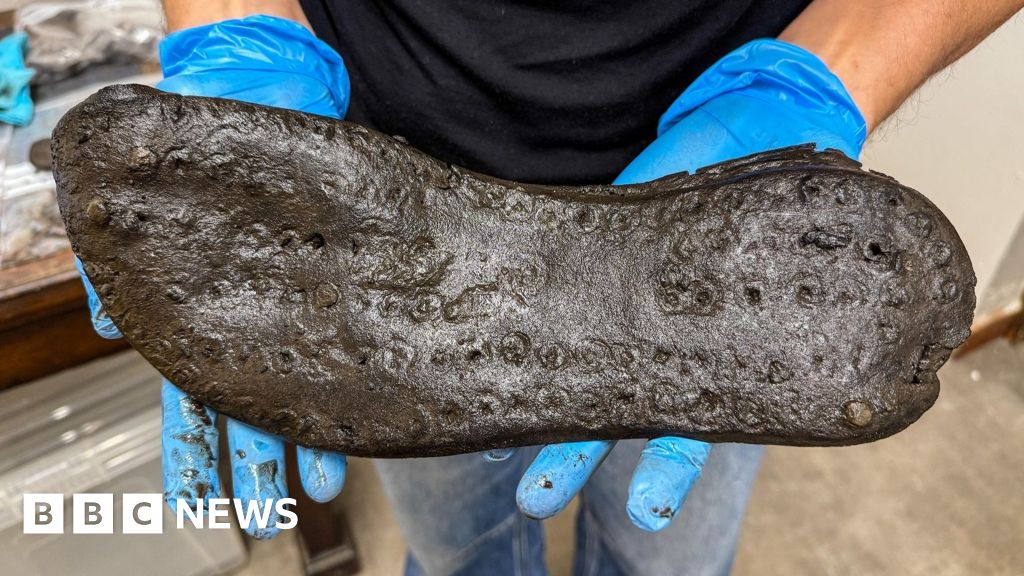Unusually large shoes discovered at a Roman fort have left archaeologists baffled. Earlier this year, 32 shoes were dug up at the Magna Roman Fort in Northumberland, eight of which were at least 30cm (11.8in) long - the equivalent of a UK size 13 to 14. In comparison, of the 5,000 discovered at the nearby Vindolanda settlement in Hexham over the past 55 years, just four or five were that large, according to Roman archaeology expert Dr Elizabeth Greene. Archaeologist Rachel Frame said it was still too early to explain the mystery behind the eight large shoes. Ms Frame said the leather shoes had all been found in a defensive ditch, which the Romans also used as rubbish dumps. The largest found at Magna Roman Fort was 32.6cm (12.8in) long, she said. She said there were several theories surrounding their origin. "We have to assume it's something to do with the people living here, having bigger feet, being potentially taller but we don't know," she said. "Are the people living there from a specific region? Could that be why their shoes are so much larger? But at the moment, it's sort of, well, this is unusual." The team knows very little about the shoes, other than the fact they are likely to be close to 2,000 years old. Later this year, it will analyse pottery found in the same soil layers as the shoes to help determine which time period they are from. This can be achieved in several ways, Ms Frame said, including looking at the style of the pottery and checking whether those styles were produced at certain times. Beyond the large shoes, the team also found children's shoes at the site. Ms Frame said the team hoped to have a better idea of who was living there at different time periods following more analysis. So many shoes have been found at both Vindolanda and Magna Roman Fort because of their ground conditions, Ms Frame said. Due to low oxygen conditions in the soil at the sites, the leather shoes have been preserved for centuries. The team also recently found a wooden hair comb on the site. "It looks like a modern day knit comb," said Ms Frame. Follow BBC North East onX,Facebook,NextdoorandInstagram.
Mystery over 'unusually large' Roman shoes
TruthLens AI Suggested Headline:
"Archaeologists Discover Unusually Large Roman Shoes at Northumberland Fort"
TruthLens AI Summary
Archaeologists have recently uncovered a remarkable find at the Magna Roman Fort in Northumberland, where 32 leather shoes were excavated, eight of which were unusually large, measuring at least 30 centimeters (11.8 inches) in length. This size is comparable to a UK shoe size of 13 to 14, which is rare for Roman footwear. According to Dr. Elizabeth Greene, a Roman archaeology expert, this discovery is particularly significant when compared to the 5,000 shoes found over 55 years at the nearby Vindolanda settlement, where only four or five were found to be of similar size. The large shoes were discovered within a defensive ditch, which Romans often used as a refuse dump, leading to speculation about their purpose and the individuals who wore them. Archaeologist Rachel Frame noted that while it is premature to draw conclusions, the presence of larger footwear could suggest that the inhabitants of the area may have had larger feet or were taller than average, possibly indicating a regional variation in physical characteristics.
The team has yet to establish a definitive timeline for the shoes, but they are believed to be nearly 2,000 years old. Further analysis of pottery found in the same soil layers as the shoes is planned for later this year, which could provide insights into the time period of their creation. This analysis will involve examining the pottery's style and correlating it with known production periods. In addition to the large shoes, the excavation also yielded children's footwear, which could help paint a broader picture of the community living at the fort during various historical periods. The exceptional preservation of these leather artifacts is attributed to the low oxygen conditions of the soil, which has safeguarded them for centuries. The discovery of a wooden hair comb, reminiscent of a modern knitting comb, further enriches the archaeological context of the site, prompting researchers to seek a deeper understanding of the lives of those who once inhabited Magna Roman Fort.
TruthLens AI Analysis
You need to be a member to generate the AI analysis for this article.
Log In to Generate AnalysisNot a member yet? Register for free.
